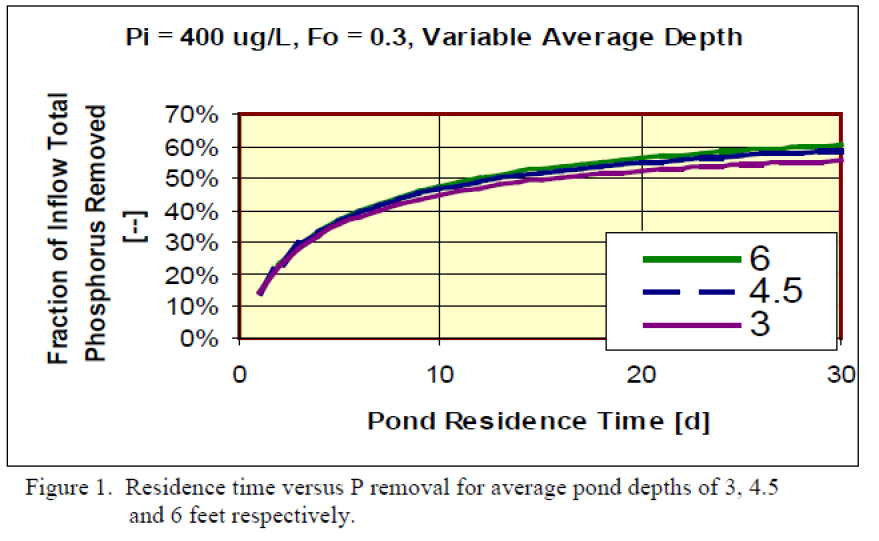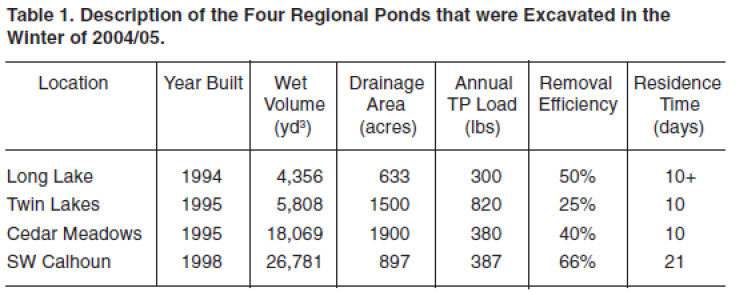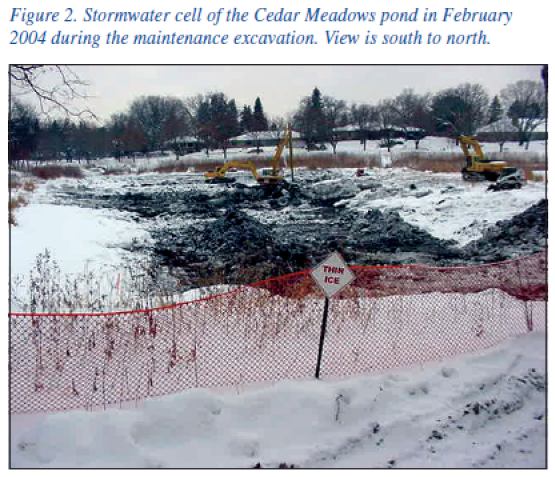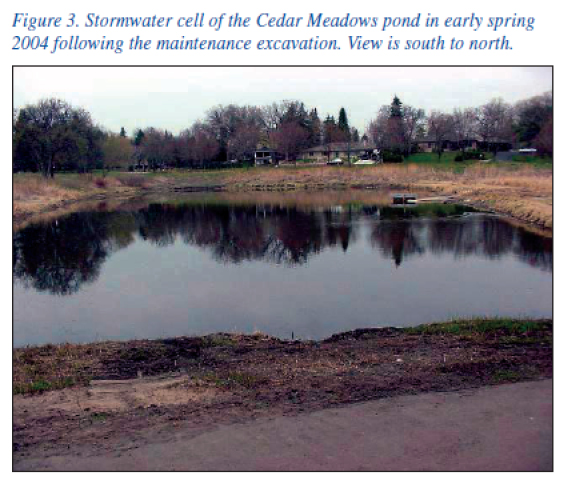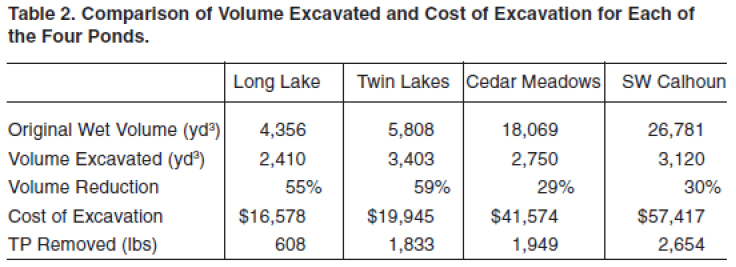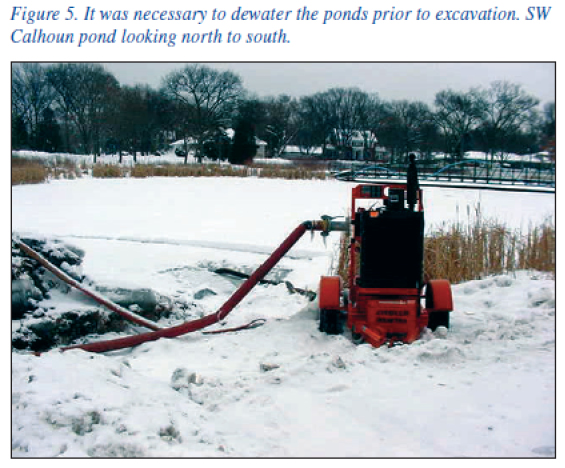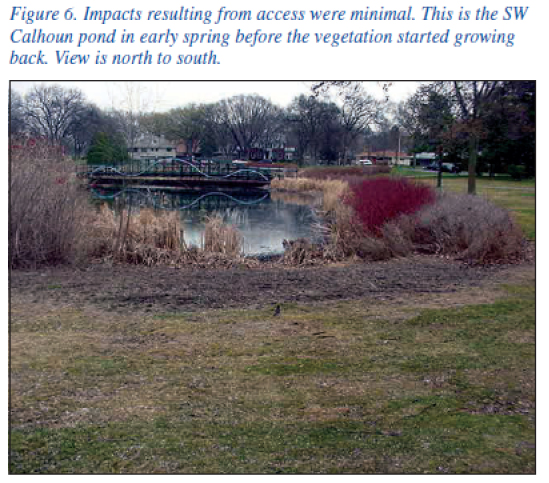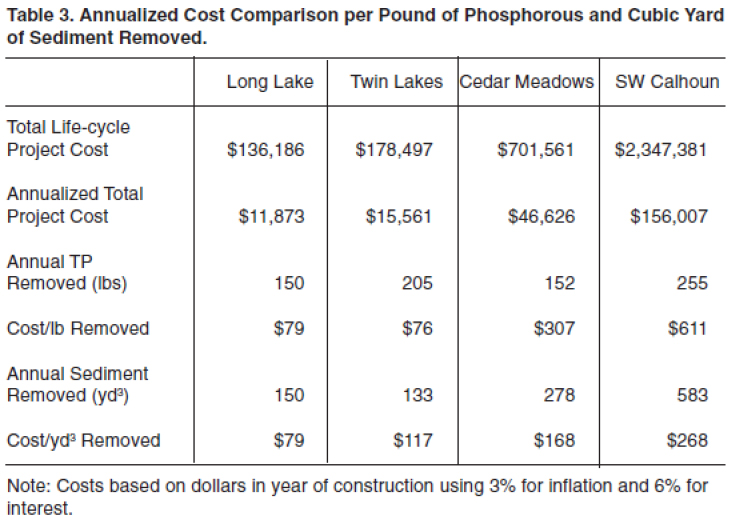
Case Study #11: Stormwater Retention Ponds: Maintenance vs. Efficiency
Jim Hafner at the City of Blaine and Mike Panzer at Wenck Associates, Inc.
Introduction
The treatment of stormwater runoff is a relatively new practice. The Clean Water Act (1972, 1977) made us aware of the impact of pollutants on our water resources. The 1987 amendments to the Clean Water Act contain provisions that significantly increase efforts to address water quality in urban runoff. It was nearly a decade after the original CWA before regulatory practices included management of stormwater runoff. However, some Metro-area watershed districts in Minnesota implemented storm water treatment regulations in the 1970’s. Wet retention ponds, or National Urban Runoff Program (NURP) ponds as they have come to be called, became one of the most accepted and effective best management practices for treating runoff and removing harmful nutrients. With a phosphorous removal range of 40% to 60%, and higher removal efficiency for suspended solids, these ponds soon dotted the landscape in an effort to improve and preserve the quality of lakes, streams and wetlands.
NURP ponds collect a variety of pollutants transported in the runoff. Nutrients such as nitrogen and phosphorous are common as are heavy metals. However, sediment, or soil particles (including organic particulates), constitutes a large portion of the load received by the ponds. Sediment build-up quickly became a significant consideration as it was evident that excess sediment reduced the volume of water a pond was able to retain. Studies have shown that this loss of capacity due to sediment also reduces the pond efficiency (based upon the physics of a particle settling by gravity in a liquid medium and the life cycle of algae and how long it takes to convert soluble P to particulate P), a matter discussed later in this article. It was evident that pond maintenance must be an integral component for each of these facilities. Initial estimates indicated that large ponds, those treating hundreds of acres, would require maintenance on an infrequent basis, perhaps every eight to twelve years or more depending on the condition of the drainage area. The experience of one watershed district has proven differently.
The Minnehaha Creek Watershed District (MCWD), a metropolitan watershed district in Minneapolis and its western suburbs, has constructed several regional NURP ponds since 1995. A 1996 regulatory revision in District rules required NURP ponds for stormwater management on many development projects. Maintenance agreements were mandatory on all of these projects and permits. However, by 2003, working under the assumption that pond maintenance was necessary on an infrequent basis, only one of the regional ponds had been dredged for sediment removal.
Maintenance frequencies
As a result of a growing concern over the number of ponds and other best management practices (BMP), and the ability to maintain an adequate phosphorous removal efficiency in these facilities, the MCWD Board of Managers requested District Engineer Mike Panzer of Wenck Associates, Inc. to review maintenance requirements. Panzer’s report included a review of NURP standards and Dr. William Walker’s PondNet equation. He concluded that the residence or retention time, (the length of time a given volume of runoff is retained in a pond) was critical to its removal efficiency. Furthermore, the rate of sediment accumulation was a direct factor in reducing residence time.
Using Walker’s equation as a basis, Panzer showed that an initial residence time of 20+ days, with 21 days being optimal, resulted in a nutrient removal efficiency of 55%. If pond efficiency dropped to 45% it was the equivalent of losing 10 days or approximately 50% of the residence time. In other words, a reduction in volume is proportional to a corresponding reduction in residence time, as illustrated in Figure 1. This relationship between sediment accumulation and reduction in removal efficiency is illustrated in the MCWD’s experience of maintaining their regional stormwater treatment facilities. Other factors related to better pond maintenance were also made evident and are shared here to improve the overall approach to pond maintenance.
Inspections in the winter and spring of 2004 on four of the regional ponds revealed significant deposits of sediment. The ponds to be excavated were: Long Lake Park, adjacent to Long Lake in the City of Long Lake; Twin Lakes Park in the City of St. Louis Park and draining to Cedar Lake; Cedar Meadows in the City of Minneapolis, adjacent to Cedar Lake; and SW Calhoun, adjacent to Lake Calhoun in the City of Minneapolis. Table 1 provides some statistics relative to each of the ponds. Annual total phosphorous (TP) is the annual average load measured by regular water quality monitoring. Removal efficiency is calculated by performance monitoring and reflects the mass balance of TP into and out of the ponds. Twin Lakes pond and Cedar Meadows both drain to Cedar Lake but treat different watershed areas and have separate outlets to the lake. District engineers estimated the volumes of sediment to be removed from each pond in preparation for a competitive bidding process leading to performing the work in the winter of 2004/05. Winter excavation is preferred to minimize impacts to the landscape and facilitate equipment access on otherwise soft ground.
Prior to the bidding process, meetings were held with each of the cities and the Minneapolis Park Board to communicate details, secure permits that may be required, agree on access/haul routes and discuss any special needs for each site. Another outcome of these meetings was the updating of previous maintenance agreements. Pre-construction communication has proven to be essential for successful maintenance projects. Residents near the sites are always curious as to what is going on and why. Their first calls are to the cities and having city staff well informed alleviates unnecessary problems for all parties involved.
Post-construction statistics offer further support for the relationship between sediment accumulation, reduced residence time and reduced removal efficiency. Table 2 itemizes volumes excavated, percent reduction in volume before excavation, and costs of excavation. Performance monitoring data were not collected in the season prior to maintenance. Consequently, the estimate of reduced efficiency is based on the graph in Figure 1. The accepted standard is if a pond volume is reduced by accumulated sediment to 50% of the original volume, it is time to remove the sediment. Based on the comparison of volume removed to original pond volume in the subject ponds, it is safe to assume that efficiency had been reduced significantly.
Cost analysis
Every discussion of maintenance includes the cost of such an activity. It can be assumed that the uncertainty of these costs causes delays in maintenance and perhaps the hesitancy to construct treatment facilities in the first place. Incorrectly calculating the costs can result in grossly under or over stating the cost of treatment leading to inaccurate assumptions on maintenance and the financial feasibility of stormwater treatment in general. If the volume removed or the pounds of phosphorous removed were simply compared to the cost of excavation, it would appear that these ponds were very cost efficient. However, original construction costs cannot be left out of the equation. Without the pond there would be nothing to be removed, except perhaps large deltas of sediment in the lakes themselves.
In order to obtain an accurate picture of total costs per pound or cubic yard removed from the ponds, all dollars spent – construction, maintenance, etc., were annualized for each pond based on the year that facility was constructed. Inflation was averaged at 3% per year and interest at 6% per year. Table 3 shows the comparisons for those numbers. While the cost per pound/cubic yard is higher than using only excavation costs, the result is a true accounting of the financial value of the ponds. This provides a more accurate measure of the cost of cleaning up and maintaining our water resources. Conversely, we see the negative costs of not protecting those resources. Cumulative records that will include the costs of future maintenance activities may provide an even more accurate financial picture and perhaps reveal lower unit costs over time.
Recommendations
Project evaluation is a critical component if one is to be more efficient and cost effective. In this particular case, our post-project evaluation revealed some very important lessons learned:
- We under-estimated the frequency for pond maintenance. The standard for maintenance has been to excavate when one half the pond volume has been reduced. This was previously estimated to occur somewhere between 8 and twelve years after the original construction. In urban areas with storm sewers, we discovered this condition can occur in as little as five years and, in some cases, even sooner.
- We need a closer assessment of the infrastructure transporting runoff to treatment facilities. In the case of Twin Lakes Park, the topography is relatively flat, resulting in a significant sediment build up in the storm sewer pipes. This condition was not fully evident when the pond was built. Certainly, sediment accumulation in the pond is better than in the lake. However, the costs of cleaning storm sewers should be evaluated when designing retention ponds and determining their location. Is it more cost efficient to clean the sewer pipes on a regular basis? How will the storm sewer conditions affect the performance and finances of stormwater treatment facilities? Will the ponds need to be maintained more frequently if the storm sewer pipes are not maintained?
- There is a direct correlation between sediment accumulation and the reduction of pond residence time. This results in a corresponding reduction in the removal efficiency of the pond. Logically, the less capacity a pond has, the less water it can hold and that means the water will flow through the pond faster. The purpose of the pond is to settle sediments and nutrients in the pond before the treated water flows downstream. A shorter residence time means less material is being retained in the pond and more material has the potential to enter downstream waters.
- All retention/detention ponds, regardless of size, should be added to your annual inspection schedule. Unexpected events such as large or frequent storms result in heavier than normal sediment deposition reducing pond capacity sooner than anticipated. Regular inspections could avoid unwanted surprises. Ponds can easily be checked during the winter in most years. Using hand held sonar devices to measure the depth to the pond bottom is a simple method to aid in calculating a reduction in capacity. Having as built plans for the pond and a known, surveyed elevation close to the pond is also important in using this method.
- Lead time from inspection to excavation can be as much as one year. Winter inspections mean pond clean out will not occur until the following winter when conditions are most conducive for maintenance. A good rule of thumb is to thoroughly inspect a pond two years after construction or two years after the previous maintenance excavation, whichever occurs first. This will avoid the surprise of greatly reduced pond volumes and ensure that maintenance will occur before pond efficiencies are reduced to unacceptable levels.
- Improved inspections can lead to lower over all maintenance costs. A significant portion of pond maintenance is realized in hauling the excavated material to a disposal site. If maintenance occurs sooner there will, in theory, be smaller loads to remove, resulting in potentially lower total costs and more favorable unit costs.
- Schedule performance monitoring for the ponds to be excavated at least one season prior to the work. This will assist in more accurate determination of actual pond efficiencies.
What works in one area does not always work in another. However, we will likely be relying on wet ponds or some variation thereof to treat our stormwater runoff for some time. There will always be sediment transported in that runoff to the treatment facilities. Sediment accumulation leads to reduced residence time in the ponds, which means reduced nutrient removal efficiency resulting in decreased water quality in lakes and streams. Simple adjustments in our maintenance schedules and a closer attention to detail will result in improved water quality and the satisfaction of contributing to the bigger picture of protecting our valuable water resources.
Return to Case Studies or continue to Other Resources.
